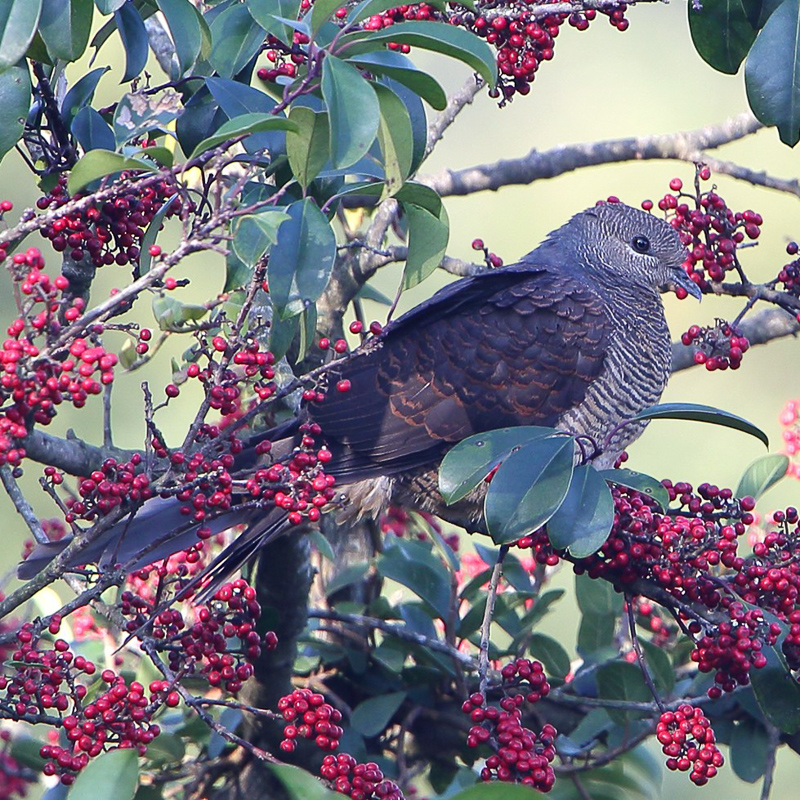Barred Cuckoo-Dove Macropygia unchall 斑尾鵑鳩
Category I. Rare to scarce winter visitor and passage migrant to well-wooded areas; appears to be increasing.
IDENTIFICATION

Apr. 2020, Matthew Kwan. Male.
37-41 cm. A slender dove with a relatively long neck and long barred tail. Males have a pinkish-grey head, a green sheen on the nape and neck-sides, blackish-brown upperparts densely barred and fringed with rufous, a blackish-brown tail barred with rufous, and vinous-brown underparts.

Jan. 2014, Michelle and Peter Wong. Female.
Females are duller and have fine dark bars on the head and throat and black scales on the breast.

Jan. 2023, Michelle and Peter Wong. Male.
Adult males are rather plain below with a vinous or bluish sheen to the chest. The long tail is shown well here.
VOCALISATIONS
The song is a series of deep slightly modulated ‘whooo’ notes at intervals of 1-2 seconds.
DISTRIBUTION & HABITAT PREFERENCE
Recorded in various parts of the New Territories, including the Deep Bay area, and once on HK Island. Wooded habitats, mainly in the lowlands but occasionally up to about 800 metres asl, are favoured, especially closed-canopy forest and shrubland, but occasionally also stands of trees on the edge of farmland or fishponds.
OCCURRENCE
All records are of single birds on 1 September and in the periods 9 November to 18 February and 28 March to 5 May.
Following the first record on 24 January 1960, there were only two further records prior to the present century: 6-12 December 1989 and 5 May 1998. Subsequently, after an isolated record on 25 April 2006, it was recorded annually from 2014. Whilst the increase no doubt reflects increased observer coverage, it also appears to be genuine, possibly reflecting a growing regional population.
BEHAVIOUR, FORAGING & DIET
Birds perch quietly for long periods, usually in a concealed position in the canopy of a tree or sometimes from a more open position on an overhead wire or the top of a fence. They feed in fruiting trees, the only species identified being an Ilex rotunda var microcarpa at Tai Po Kau Headland, and occasionally forage on open ground, including the edge of a fishpond at San Tin where stale bread was liberally scattered.
RANGE & SYSTEMATICS
Widely distributed from the western Himalayas and northeast India through Burma and Indochina to southeast China and from the Malaysian Peninsula to Flores (Baptista et al. 1997).
Of the subspecies occurring in China, M. u. usalia is distributed in the west of the country east to Yunnan and Sichuan, and presumably also accounts for recent records from Shaanxi, while M. u. minor is resident on Hainan and occurs very locally as a resident or summer visitor in hill forests from southwest Guangxi east to Zhejiang, including Guangdong (Liu and Chen 2021).
CONSERVATION STATUS
IUCN: Least Concern. Population trend stable.
Baptista, L. F., P. W. Trail, and H. M. Horblit. (1997(. Family Columbidae (Pigeons and Doves). Pp. 60-243 in: del Hoyo, J., A. Elliot and J. Sargatal. Handbook of the Birds of the World, vol. 4: Sandgrouse to Cuckoos. Lynx Edicions, Barcelona, Spain.
Liu, Y. and S. H. Chen (eds) (2021). The CNG Field Guide to the Birds of China (in Chinese). Hunan Science and Technology Publication House, Changsha.

